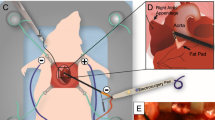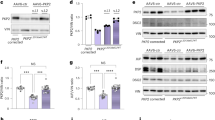Abstract
Cardiac arrest is the leading cause of death in the United States and other developed countries. Ventricular tachyarrhythmias are the most prominent cause of cardiac arrest, and patients with structural heart disease are at increased risk for these abnormal heart rhythms. Drug and device therapies have important limitations that make them inadequate to meet this challenge. We and others have proposed development of arrhythmia gene therapy as an alternative to current treatment methods. In this review, I discuss the basic mechanisms of ventricular arrhythmias and summarize the literature on the use of gene therapy for ventricular tachyarrhythmias.
This is a preview of subscription content, access via your institution
Access options
Subscribe to this journal
Receive 12 print issues and online access
$259.00 per year
only $21.58 per issue
Buy this article
- Purchase on Springer Link
- Instant access to full article PDF
Prices may be subject to local taxes which are calculated during checkout


Similar content being viewed by others
References
Roger VL, Go AS, Lloyd-Jones DM, Benjamin EJ, Berry JD, Borden WB et al. Heart disease and stroke statistics–2012 update: a report from the American Heart Association. Circulation 2012; 125: e2–e220.
Rea TD, Pearce RM, Raghunathan TE, Lemaitre RN, Sotoodehnia N, Jouven X et al. Incidence of out-of-hospital cardiac arrest. Am J Cardiol 2004; 93: 1455–1460.
Echt D, Liebson P, Mitchell L, Peters R, Obias-Manno D, Barker A et al. Mortality and morbidity in patients receiving encainide, flecainide, or placebo. N Engl J Med 1991; 324: 781–788.
Waldo A, Camm A, deRuyter H, Friedman P, MacNeil D, Pauls J et al. Effect of d-sotalol on mortality in patients with left ventricular dysfunction after recent and remote myocardial infarction. Lancet 1996; 348: 7–12.
Kuck K, Cappato R, Siebels J, Ruppel R . Randomized comparison of antiarrhythmic drug therapy with implantable defibrillators in patients resuscitated from cardiac arrest: the Cardiac Arrest Study Hamburg (CASH). Circulation 2000; 102: 748–754.
Singh SN, Fletcher RD, Fisher SG, Singh BN, Lewis HD, Deedwania PC et al. Amiodarone in patients with congestive heart failure and asymptomatic ventricular arrhythmia. Survival trial of antiarrhythmic therapy in congestive heart failure. N Engl J Med 1995; 333: 77–82.
Kober L, Bloch Thomsen PE, Moller M, Torp-Pedersen C, Carlsen J, Sandoe E et al. Effect of dofetilide in patients with recent myocardial infarction and left-ventricular dysfunction: a randomised trial. Lancet 2000; 356: 2052–2058.
Alter P, Waldhans S, Plachta E, Moosdorf R, Grimm W . Complications of implantable cardioverter defibrillator therapy in 440 consecutive patients. Pacing Clin Electrophysiol 2005; 28: 926–932.
Gould P, Krahn A . Complications associated with implantable cardioverter-defibrillator replacement in response to device advisories. JAMA 2006; 295: 1907–1911.
Janse MJ, Wit AL . Electrophysiological mechanisms of ventricular arrhythmias resulting from myocardial ischemia and infarction. Physiol Rev 1989; 69: 1049–1169.
Carmeliet E . Cardiac ionic currents and acute ischemia: from channels to arrhythmias. Physiol Rev 1999; 79: 917–1017.
Goldberg S, Greenspon AJ, Urban PL, Muza B, Berger B, Walinsky P et al. Reperfusion arrhythmia: a marker of restoration of antegrade flow during intracoronary thrombolysis for acute myocardial infarction. Am Heart J 1983; 105: 26–32.
Woodcock EA, Arthur JF, Matkovich SJ . Inositol 1,4,5-trisphosphate and reperfusion arrhythmias. Clin Exp Pharmacol Physiol 2000; 27: 734–737.
Brooks WW, Conrad CH, Morgan JP . Reperfusion induced arrhythmias following ischaemia in intact rat heart: role of intracellular calcium. Cardiovasc Res 1995; 29: 536–542.
Valverde CA, Kornyeyev D, Ferreiro M, Petrosky AD, Mattiazzi A, Escobar AL . Transient Ca2+ depletion of the sarcoplasmic reticulum at the onset of reperfusion. Cardiovasc Res 2010; 85: 671–680.
Yumoto A, Fukushima KK, Nakamura K, Hashimoto K, Aoki M, Morishita R et al. Hepatocyte growth factor gene therapy reduces ventricular arrhythmia in animal models of myocardial ischemia. Acta Med Okayama 2005; 59: 73–78.
Yoshida H, Zhang JJ, Chao L, Chao J . Kallikrein gene delivery attenuates myocardial infarction and apoptosis after myocardial ischemia and reperfusion. Hypertension 2000; 35: 25–31.
Sharma JN . Cardiovascular activities of the bradykinin system. Scientific World Journal 2008; 8: 384–393.
del Monte F, Lebeche D, Guerrero JL, Tsuji T, Doye AA, Gwathmey JK et al. Abrogation of ventricular arrhythmias in a model of ischemia and reperfusion by targeting myocardial calcium cycling. Proc Natl Acad Sci USA 2004; 101: 5622–5627.
Hajjar R, Schmidt U, Matsui T, Guerrero L, Lee K, Gwathmey J et al. Modulation of ventricular function through gene transfer in vivo. Proc Natl Acad Sci USA 1998; 95: 5251–5256.
Prunier F, Kawase Y, Gianni D, Scapin C, Danik SB, Ellinor PT et al. Prevention of ventricular arrhythmias with sarcoplasmic reticulum Ca2+ ATPase pump overexpression in a porcine model of ischemia reperfusion. Circulation 2008; 118: 614–624.
Peters N, Coromilas J, Severs N, Wit A . Disturbed connexin43 gap junction distribution correlates with the location of reentrant circuits in the epicardial border zone of healing canine infarcts that cause ventricular tachycardia. Circulation 1997; 95: 988–996.
Dun W, Boyden P . Diverse phenotypes of outward currents in cells that have survived in the 5-day-infarcted heart. Am J Physiol 2005; 289: H667–H673.
Jiang M, Cabo C, Yao J, Boyden P, Tseng G . Delayed rectifier K currents have reduced amplitudes and altered kinetics in myocytes from infarcted canine ventricle. Cardiovasc Res 2000; 48: 34–43.
Lue W, Boyden P . Abnormal electrical properties of myocytes from chronically infarcted canine heart. Circulation 1992; 85: 1175–1188.
Pu J, Boyden P . Alterations of Na+ currents in myocytes from epicardial border zone of the infarcted heart. A possible ionic mechanism for reduced excitability and postrepolarization refractoriness. Circ Res 1997; 81: 110–119.
Lau DH, Clausen C, Sosunov EA, Shlapakova IN, Anyukhovsky EP, Danilo Jr P et al. Epicardial border zone overexpression of skeletal muscle sodium channel SkM1 normalizes activation, preserves conduction, and suppresses ventricular arrhythmia: an in silico, in vivo, in vitro study. Circulation 2009; 119: 19–27.
Lau DH, Clausen C, Sosunov EA, Shlapakova IN, Anyukhovsky EP, Danilo Jr P et al. Epicardial border zone overexpression of skeletal muscle sodium channel SkM1 normalizes activation, preserves conduction, and suppresses ventricular arrhythmia: an in silico, in vivo, in vitro study. Circulation 2009; 119: 19–27.
Coronel R, Lau DH, Sosunov EA, Janse MJ, Danilo Jr P, Anyukhovsky EP et al. Cardiac expression of skeletal muscle sodium channels increases longitudinal conduction velocity in the canine 1-week myocardial infarction. Heart Rhythm 2010; 7: 1104–1110.
Yang B, Lin H, Xiao J, Lu Y, Luo X, Li B et al. The muscle-specific microRNA miR-1 regulates cardiac arrhythmogenic potential by targeting GJA1 and KCNJ2. Nat Med 2007; 13: 486–491.
Fishbein MC, Maclean D, Maroko PR . Experimental myocardial infarction in the rat: qualitative and quantitative changes during pathologic evolution. Am J Pathol 1978; 90: 57–70.
Sasano T, McDonald AD, Kikuchi K, Donahue JK . Molecular ablation of ventricular tachycardia after myocardial infarction. Nat Med 2006; 12: 1256–1258.
Sasano T, Kelemen K, Greener ID, Donahue JK . Ventricular tachycardia from the healed myocardial infarction scar: validation of an animal model and utility of gene therapy. Heart Rhythm 2009; 6: S91–S97.
Sasano T, Kikuchi K, Feng N, McDonald A, Lai S, Donahue J . Targeted high-efficiency, homogeneous myocardial gene transfer. J Mol Cell Cardiol 2007; 42: 954–961.
Lyon AR, Bannister ML, Collins T, Pearce E, Sepehripour AH, Dubb SS et al. SERCA2a gene transfer decreases sarcoplasmic reticulum calcium leak and reduces ventricular arrhythmias in a model of chronic heart failure. Circ Arrhythm Electrophysiol 2011; 4: 362–372.
Rosenbaum DS, Jackson LE, Smith JM, Garan H, Ruskin JN, Cohen RJ . Electrical alternans and vulnerability to ventricular arrhythmias. N Engl J Med 1994; 330: 235–241.
Cutler MJ, Wan X, Laurita KR, Hajjar RJ, Rosenbaum DS . Targeted SERCA2a gene expression identifies molecular mechanism and therapeutic target for arrhythmogenic cardiac alternans. Circ Arrhythm Electrophysiol 2009; 2: 686–694.
Brunner M, Kodirov S, Mitchell G, Buckett P, Shibata K, Folco E et al. In vivo gene transfer of Kv1.5 normalizes action potential duration and shortens QT interval in mice with long QT phenotype. Am J Physiol 2003; 285: H194–H203.
Kaufman ES . Mechanisms and clinical management of inherited channelopathies: long QT syndrome, Brugada syndrome, catecholaminergic polymorphic ventricular tachycardia, and short QT syndrome. Heart Rhythm 2009; 6: S51–S55.
London B, Jeron A, Zhou J, Buckett P, Han X, Mitchell GF et al. Long QT and ventricular arrhythmias in transgenic mice expressing the N terminus and first transmembrane segment of a voltage-gated potassium channel. Proc Natl Acad Sci USA 1998; 95: 2926–2931.
Kodirov S, Brunner M, Busconi L, Koren G . Lonng-term restitution of 4-aminopyridine-sensitive currents in Kv1DN ventricular myocytes using adeno-associated virus-mediated delivery of Kv1.5. FEBS Lett 2003; 550: 74–78.
Denegri M, Avelino-Cruz JE, Boncompagni S, De Simone SA, Auricchio A, Villani L et al. Viral gene transfer rescues arrhythmogenic phenotype and ultrastructural abnormalities in adult calsequestrin-null mice with inherited arrhythmias. Circ Res 2012; 110: 663–668.
Acknowledgements
This work was funded by the grants from the National Institutes of Health (HL67148, HL93486 and EB2846).
Author information
Authors and Affiliations
Corresponding author
Ethics declarations
Competing interests
The author declares no conflict of interest.
Rights and permissions
About this article
Cite this article
Donahue, J. Gene therapy for ventricular tachyarrhythmias. Gene Ther 19, 600–605 (2012). https://doi.org/10.1038/gt.2012.35
Received:
Revised:
Accepted:
Published:
Issue Date:
DOI: https://doi.org/10.1038/gt.2012.35
Keywords
This article is cited by
-
Prevailing Effects of Ibutilide on Fast Delayed Rectifier K+ Channel
The Journal of Membrane Biology (2019)
-
Gene therapies for arrhythmias in heart failure
Pflügers Archiv - European Journal of Physiology (2014)
-
In vivo reprogramming for heart disease
Cell Research (2012)



